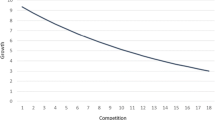Abstract
This paper used concepts from chaotical dynamic systems, information theory, and cybernetics to develop a model that depicts a Schumpeterian process through which entrepreneurs search for new combinations of both products and production processes that result in increased productivity and growth. The model provides the basis for an alternative conceptual framework for conducting research into the causes of the productivity slowdown that began in the United States in the early 1970s and continued until recently.
Similar content being viewed by others
References
Ashby, W. Ross, 1964, Introduction to Cybernetics, London: Methuen & Co. Ltd.
Abernathy, William and Kim B. Clark, 1985, ‘Innovation: Mapping the Winds of Creative Destruction’, Research Policy 14(1) (January).
Abernathy, William and James M. Utterback, 1978, ‘Patterns of Industrial Innovation’, Technology Review 80(7) (June/July), 40–47.
Arrow, Kenneth J., 1962, ‘The Economic Implications of Learning by Doing’, Review of Economic Studies 29 (June), 155–173.
Barro, Robert J. and Xavier Sala i Martin, 1992, ‘Convergence’, Journal of Political Economy 100(2) (April), 223–251.
Baumol, William J. and Edward N. Wolff, 1992, ‘Feedback Between R&D and Productivity Growth: A Chaos Model’, in Jess Benhabib (ed.), Cycles and Chaos in Economic Equilibrium, New Jersey: Princeton University Press.
Beltrami, Edward, 1987, Mathematics for Dynamic Modeling, Boston: Academic Press.
Bergé, Pierre, Yves Pomeau and Christian Vidal, 1984, Order Within Chaos, New York: John Wiley & Sons.
Boldrin, Michele and Raymond J. Deneckere, 1990, ‘Sources of Complex Dynamics in Two-Sector Growth Models’, Journal of Economic Dynamics and Control 14, 627–653.
Bright, Arthur A., Jr., 1949, The Electric Lamp Industry: Technological Change and Economic Development from 1800 to 1947, New York: Macmillan.
Collet, P. and J. P. Eckmann, 1980, Iterated Maps On The Interval As Dynamical Systems, Boston, MA: Birkhaüser.
Drucker, Peter F., 1993, Post-Capitalist Society, New York: HarperBusiness.
Grossman, Gene and Elhanan Helpman, 1989, ‘Product Development and International Trade’, Journal of Political Economy 97(6) (December), 1261–1283.
Hogendorn, Jan S., 1987, Economic Development, New York: Harper & Row.
Jenner, Richard A., 1994a, ‘Schumpeterian Growth, Public Policy, Chaos and the Formation of Dissipative Structures’, Journal of Evolutionary Economics 2 (Spring).
Jenner, Richard A., 1994b, ‘The Productivity Paradox, Chaotic Systems, and Dissipative Enterprises’, Proceedings of the IEEE 1994 International Engineering Management Conference (October 17–19), 280–290.
Jenner, Richard A., 1991, ‘Technological Paradigms, Innovative Behavior and the Formation of Dissipative Structures’, Small Business Economics (Fall).
Jenner, Richard A., 1989, ‘Dissipative Structures, Control and Innovative Behavior in Monopolies’, The Journal of Interdisciplinary Economics 3(1), 47–61.
Jenner, Richard A., 1966, ‘An Information Version of Pure Competition’, Economic Journal 76(304) (December), 786–805.
Judd, K. L., 1985, ‘On the Performance of Patents’, Econometrica 53(3) (May), 567–585.
Lewis, W. Arthur, 1955, The Theory of Economic Growth, London.
Prigogine, Ilya and Isabelle Stengers, 1984, Order Out of Chaos, Toronto: Bantam Books.
Romer, Paul M., 1986, ‘Increasing Returns and Long-Run Growth’, Journal of Political Economy 94(5) (October), 1002–1037.
Romer, Paul M., 1987, ‘Crazy Explanations for the Productivity Slowdown’, in S. Fischer (ed.), NBER Macroeconomics Annual, Cambridge: MIT Press, pp. 163–202.
Romer, Paul M., 1994, ‘The Origins of Endogenous Growth’, Journal of Economic Perspectives 8(1) (Winter), 3–22.
Schumpeter, Joseph A., 1934, The Theory of Economic Development (1983 Edition, John Elliott, Ed.), New Brunswick, NH: Transaction Publishers.
Senge, Peter M., 1990, The Fifth Discipline: The Art and Practice of the Learning Organization, New York: Doubleday.
Shaw, Robert, 1981, ‘Strange Attractors, Chaotic Behavior, and Information Theory’, Zeitschrift für Naturforschung 36a, 80–92.
Shell, Karl, 1966, ‘Toward a Theory of Inventive Activity and Capital Accumulation’, American Economic Review 56 (May), 62–68.
Utterback, James M., 1994, Mastering the Dynamics of Innovation, Boston, Mass: Harvard Business School Press.
Zuboff, Shoshana, 1988, In The Age of the Smart Machine, New York: Basic Books.
Author information
Authors and Affiliations
Rights and permissions
About this article
Cite this article
Jenner, R.A. Endogenous Schumpeterian Growth, the Productivity Slowdown, and Entrepreneurial Dynamics. Small Business Economics 11, 343–351 (1998). https://doi.org/10.1023/A:1008099431979
Issue Date:
DOI: https://doi.org/10.1023/A:1008099431979




